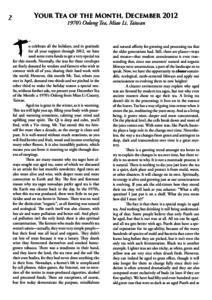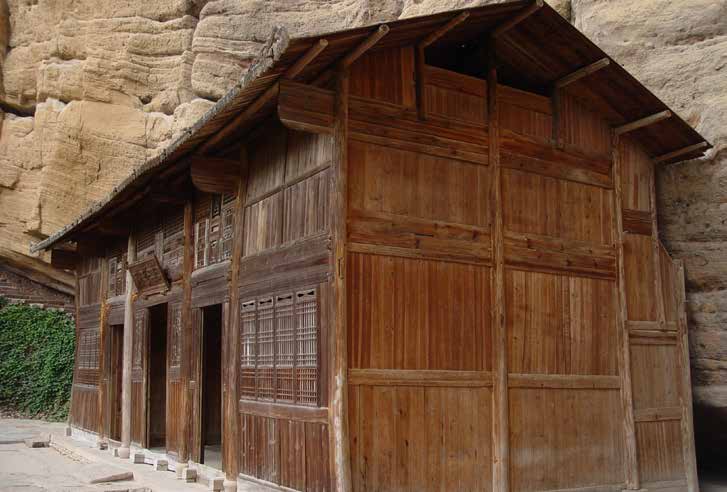
 |
|
To celebrate all the holidays, and in gratitude for all your support through 2012, we have used some extra funds to get a very special tea for this month. Normally, the teas for these envelopes are freely donated by vendors and farmers who wish to connect with all of you, sharing their hard work with the world. However, this month Mr. Tsai, whom you met in April, donated two-thirds and we pitched in the other third to make the holiday season a special one. So, without further ado, we present your December Tea of the Month: a 1970's Oolong from Miao Li County, Taiwan. Aged tea is great in the winter, as it is warming.
This tea will light you up, filling your body with peaceful and warming sensations, calming your mind and uplifting your spirit. The Qi is deep and calm, you'll find, with a Yin rising. Mr. Tsai stored this tea himself for more than a decade, so the energy is clean and pure. It is well-stored without much mustiness, so you will find berries and fruit, wood and incense overlaying many other flavors. It is also incredibly patient, which means you can brew it morning to night through dozens of steepings.
There are many reasons why tea sages have always sought out aged tea, some of which we discussed in an article for last month's newsletter. Aged trees are also more alive and wise, with deeper roots and more connection to Earth and Sky. The first and foremost reason why tea sages nowadays prefer aged tea is that the Earth was cleaner back in the day. In the 1970's, when this tea was produced, there were little to no pesticides used on tea farms in Taiwan. There was no need for the distinction "organic", as all farming was natural and ecological. The earth itself was also cleaner, with less air and water pollution and better soil. And physical pollution isn't the only kind; there is also spiritual contamination. The farmers who made this month's tea weren't saints - actually, they were very simple people - but their food was all local and organic. They didn't eat lots of meat because it was a luxury. They drank wine they fermented themselves and smoked homegrown tobacco. There was a steadiness in their hand, and they knew the land, the tea trees and the soil like their own bodies, for they had never done anything else in their lives. Nowadays, a farmer's life is complicated by cell phones, video games, the Internet, not to mention all the toxins in mass-produced cigarettes, alcohol and processed foods. There are exceptions, of course, but few today demonstrate the purpose, mindfulness and natural affinity for growing and processing tea that the older generations had. Still, there are places - ways and means - that modern consciousness is even transcending that, since our ancestors' natural and organic lifeways were unconscious, a part of the landscape so to speak. Now, we have the opportunity to choose sustainable, ecological, earth-centered lifeways and apply our consciousness to evolving them to new heights!
A cleaner environment may explain why aged teas are favored by modern tea sages, but not why even ancient masters chose to age their tea. A living tea doesn't die in the processing; it lives on in the essence of the leaves. Tea has a way of going into retreat when it enters the jar, meditating the years away. And as a living being, it grows wiser, deeper and more concentrated. On the physical level, the cells break down and more of the juice comes out. With some teas, like Puerh, bacteria plays a large role in the change over time. Nevertheless, the way a tea changes from green and astringent to deep, dark and transcendent over time is a great mystery.

There is a growing trend amongst tea lovers to try to explain the changes in tea over time, but there really is no answer to why. It is not a manmade process; it is natural. There is nothing to do; you just leave the tea in a quiet, dark place and protect it from mold, water, or other disasters. It will change on its own. Spiritually, its energy is alive and growing just as our consciousness is evolving. If you ask the old-timers how they stored their tea they will look at you askance: "What a silly question! I just put it on a shelf. What do you mean how did I store it?!"
The fact is that there is a special magic in aged tea. And nothing but drinking it will bring understanding of that. Some people believe that only Puerh can be aged, but that is not true at all. All tea can be aged, and all tea gets better with age. Puerh does have a special reputation for its age-ability, because of the many hundreds of species of mold and bacteria that cover the leaves long before they are picked, but it isn't even the only tea with such fermentation. Black tea is another example. Lighter teas are also tricky, as white, green and yellow teas are very nice when drunk fresh. However, they can indeed be aged to great effect, though it will take longer for them to change fully since their oxidation is often arrested dramatically and they are also composed more exclusively of buds (at least if they are fine quality). We have had fifty and even hundred-year-old green teas that were as dark as an aged Puerh and asrich and full of Qi. We have at the center a 120-year-old jasmine green tea that is absolutely stunning. We also have some amazing ten-year-old Long Jing green tea. (Remind us to prepare them for you when you visit!) Still, there is also a special magic in fresh green, white and/or yellow teas. As with all things tea, there is no formula - you must choose based on each tea individually.
Oolongs age very well and often faster than Puerh. Furthermore, Puerh is a sensitive tea to age. It requires high humidity, airflow and seasonal temperature fluctuations - a subtropical environment, in other words. Otherwise, the bacteria and molds will die and the tea's Qi with them. Teas stored in dry climates often lose all Qi, as well as flavor and aroma, in ten to fifteen years. Oolong, however, prefers a dry, sealed environment without any changes at all. This means that most of you, no matter where you live, can successfully store Oolong tea with great results. Ideally, you will want to choose a tea with a bit more oxidation and heavier roast - a more full-bodied, traditional Oolong. Fill a jar completely so that there is less oxygen inside. (You may want to use a glazed jar so air doesn't come in through the pores and because the clay will influence the tea.) Seal the lid with wax, laying a string within the melted wax so that you can break the seal easily. Keep the tea somewhere dark, clean and quiet. Energy matters, so send it some love, put some affirmative words on the outside or place it near an altar. After ten, fifteen or even fifty years you will have an awesome tea awaiting a reunion.
Our Tea of the Month also comes from Miao Li, which is the home of our center, making it extra special. Most of the tea this old was not intentionally stored to start with, but rather cast aside. For that reason, it was originally not stored very well. But the decade with Mr. Tsai has more than made up for that. Nowadays, Miao Li County farmers only produce Oriental Beauty, though in the 1970's they were making more Oolong. This is a striped Oolong, akin to the Rock Teas produced in Wuyi, Fujian, which is where most Taiwanese tea farmers originally came from.
Since this is a precious tea, you may want to brew it gongfu style. And of course share it with some beloved human souls, especially since this is the season for giving, sharing and loving. May all the age and wisdom of this tea be your very own, and may it radiate from your eyes - full of your light, may it then bless all those whose paths you cross...